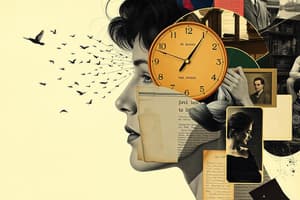Podcast
Questions and Answers
Which strategy is not recommended for enhancing visualization during reading?
Which strategy is not recommended for enhancing visualization during reading?
- Discuss mental images with a peer
- Ignore sensory details while reading (correct)
- Pause to imagine the events
- Sketch or doodle mental images
What should readers do to visualize before reading?
What should readers do to visualize before reading?
- Summarize the text they will read
- Skip the title and images
- Imagine possible outcomes of the story (correct)
- Read the text quickly without pausing
How does visualizing during reading help the reader?
How does visualizing during reading help the reader?
- It provides a clearer understanding of the plot (correct)
- It enables the reader to remember facts long-term
- It makes reading a passive experience
- It allows the reader to skip parts of the text
Which of these is an effective post-reading visualization activity?
Which of these is an effective post-reading visualization activity?
Which question is most relevant for guiding visualization while reading?
Which question is most relevant for guiding visualization while reading?
What is the main benefit of using visualization while reading?
What is the main benefit of using visualization while reading?
Which statement best describes the process of visualization in reading?
Which statement best describes the process of visualization in reading?
What should readers do to effectively visualize while reading?
What should readers do to effectively visualize while reading?
How does visualization contribute to a reader's enjoyment of a story?
How does visualization contribute to a reader's enjoyment of a story?
What is a recommended starting point for readers to begin visualizing?
What is a recommended starting point for readers to begin visualizing?
Flashcards
Visualization in Reading
Visualization in Reading
The act of forming mental images while reading, creating a movie in your mind.
Visualizing Strategy
Visualizing Strategy
A reading strategy that helps readers understand and recall information by creating mental images.
Importance of Visualization
Importance of Visualization
Visualization helps readers understand the story better by making them feel more connected to it, which leads to enjoyment.
Visualizing using all five senses
Visualizing using all five senses
Signup and view all the flashcards
Changing mental images
Changing mental images
Signup and view all the flashcards
Visualizing Before Reading
Visualizing Before Reading
Signup and view all the flashcards
Visualizing During Reading
Visualizing During Reading
Signup and view all the flashcards
Visualizing After Reading
Visualizing After Reading
Signup and view all the flashcards
Visualization Activities
Visualization Activities
Signup and view all the flashcards
Study Notes
Visualization as a Reading Strategy
- Visualization involves creating mental images while reading.
- It enhances comprehension by connecting readers to the text.
- The process of visualization involves using sensory details to imagine characters, settings, and events.
- Readers create mental pictures as if watching a movie.
How to Visualize
- Visualization involves creating images in your mind first, then add characters and details.
- Readers should consider all senses (sight, sound, smell, taste, touch).
- Visualizing should involve interacting with the story as an observer.
- Visualize using sensory details provided by the author.
- Imagination is key.
When to Visualize
- Visualize before reading to predict the story.
- Visualize during reading to monitor comprehension.
- Visualize after reading to recall events and details.
Visualization Activities
- Pause after reading part of a story to visualize what happened.
- Visualize all story elements (settings, characters, events, objects).
- Focus on one element at a time, then add others.
- Sketch or doodle mental images.
- Discuss and compare images with others.
- Act out scenes.
- Journal specific details.
- Use similar images, from other sources, to support visualization
- Effective with picture books, audio books, and chapter books.
Visualizing Poetry
- Poetry often provides sensory details, excellent for visualization practice.
- Highlighting words and phrases that help with visualization reinforces the skill.
Guiding Questions for Visualization
- What does this look like in your mind?
- How can you describe characters/setting/events with sensory details?
- Which words helped create the picture in your mind?
- Use prior knowledge to help create mental images.
- Does visualizing make reading more interesting?
Studying That Suits You
Use AI to generate personalized quizzes and flashcards to suit your learning preferences.




